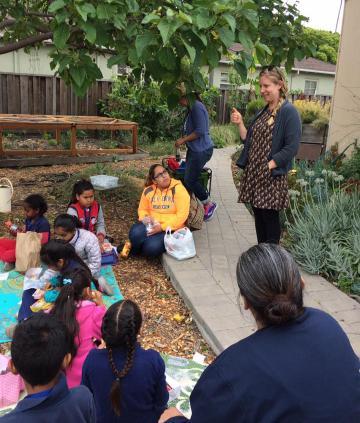Sowing the Seeds of Social Justice
Sowing the Seeds of Social Justice
Rooted in the Jesuit educational tradition of social justice, the Ignatian Center’s Arrupe Weekly Engagement program facilitates community-based learning opportunities that underscore commitments to the common good, universal human dignity, justice as participation, and solidarity with marginalized communities. By partnering with local non-profit organizations, the center provides students the opportunity to contribute to and learn from the unique challenges these partners encounter while fulfilling their SCU coursework and Experiential Learning for Social Justice (ELSJ) graduation requirement. Since its inception in 1986, our partnerships have grown from eight community organizations involving fewer than 100 students, to nearly 60 community partners engaging with nearly 1,200 student participants each year.

One such partner is the Bronco Urban Garden program. Often referred to as BUG, Bronco Urban Gardens is the food justice outreach initiative of Santa Clara University. BUG began in 2009 as a partnership with Silicon Valley Health Corps, a food justice initiative program, and in 2015 its operations were completely absorbed by the university. The gardens work in solidarity with marginalized neighborhoods, supporting their urban garden projects and spaces, to create hands-on learning experiences for students of all ages and backgrounds, including SCU students. BUG provides technical support and garden-enhanced education, aiming to increase ecological literacy, provide nutrition education and raise awareness around food access in our underserved communities.
We spoke to Lisa Martinez, Bronco Urban Gardents Educator, about her role in BUG and involvement with Arrupe students.
What is the purpose of BUG?
Creating opportunities for undergraduates to engage with local communities, while exploring themes and content taught in the classroom, is at the heart of how BUG approaches food justice. The gardens become a shared space for students to learn alongside community members as they plant and harvest or build and play together. The garden clubs at both school sites are how children and interested parents can participate in the care and maintenance of their school garden. It is in this spirit of solidarity that Arrupe placements are asked to support the BUG after-school program Garden Club.
How do Arrupe students contribute to BUG and it’s daily operations?
The Arrupe placement students participate in a number of different ways during their time with the BUG programs - whether they are working as aides during the school day in the BUG Garden Lab and Garden Time!, or leading the community in a variety of garden chores. Our school programs that operate within the school day are designed to also engage the elementary teachers, with the aim to increase their use of the garden space to further enrich their curriculum goals. Arrupe students often facilitate the ability to create small group instruction and support the overall outdoor classroom management.
How have the Arrupe placements contributed to the overall success of the program?
Arrupe placements play a key role in BUG garden-education programs, and they are positively received by the children, teachers, school staff and parents. They lead small groups of children in garden activities, which increases the amount of one-on-one time children receive. This has several teaching benefits as placements can directly support a child's writing or reading, often answering questions or guiding discussions. Seeing SCU students actively engaged with a group of 8 year-olds in seed dissections or planting with a mother and several children is immediately powerful.
How do you think placement in the BUG program has influenced the Arrupe students?
Arrupe students often talk about the personal impact connecting to members of the community has on them. In my two years as BUG Educator, several Arrupe placements have come back to work with BUG on other community-based learning projects, such as a podcast interview, writing projects, and fulfilling a desire to volunteer. While these are special cases, the students that return to BUG always inspire a new sense of energy to our programming. They directly demonstrate the endless potential each new Arrupe placement has to offer.
In your opinion, what are the biggest successes to come out of this partnership?
After working and volunteering for several years in education, I have found the Arrupe Weekly Engagement to be a unique and inspiring educational endeavor. The blending of age groups, backgrounds and experiences has led me to new ideas on inclusive programming as I am privileged to witness amazing relationships form in 8 weeks, see how concepts of solidarity can play out in real life and share some amazing vegetables along the way. It is process. It is a constant learning curve. There are some quarters that have felt more successful in achieving the BUG mission; however, the process of growing food in sustainable ways requires us to acknowledge that some seasons are more productive than others. That's how life grows. It is in the sincere and mindful efforts we make towards growing together that is the true success.
Learn more about Arrupe Weekly Engagement, Bronco Urban Gardens and the Center for Sustainability.